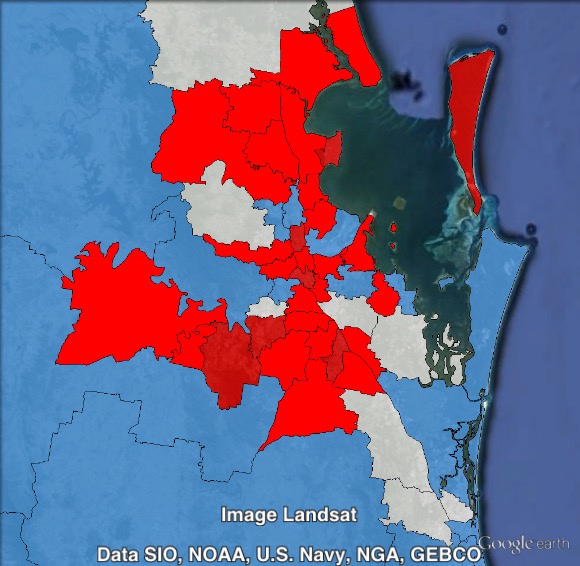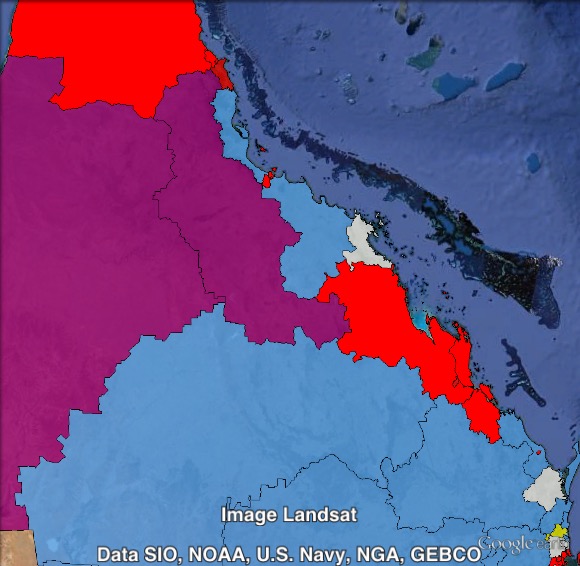This is the first in a series of wrap-up posts. I will also devote a post to going in-depth in the undecided seats, as well as a regional breakdown of the vote, and a look at how preferences flowed, over the course of today and tomorrow. I will also be tracking the results in the close seats across the course of this week to determine if Labor will be winning a majority in the Parliament.
At the moment the Liberal National Party is sitting on 40.8% of the vote across Queensland, which is a swing of 8.9%. Labor is sitting on 38.1%, a swing of 11.5%.
The Greens are on 8.4%, which is 0.9% higher than in 2012. The Palmer United Party polled 5% in their first contest in Queensland. Katter’s Australian Party’s vote dropped from 11.5% to 1.7%. This is in part due to the party running a lot less candidates, but they also performed poorly where they did run.
In terms of seats, we have a pretty good idea of the picture.
The ABC computer is currently giving 44 seats to Labor, 33 seats to the LNP, two to KAP and one to an independent. This leaves nine remaining seats undecided. At the moment the LNP is leading in seven of those nine seats, so the most likely current outcome is 46 to Labor, and 40 to the LNP. There is a small chance of Labor not winning a majority if they fall short in all nine close races, but that seems unlikely.
Having said that, there are two seats which the ABC has given to Labor which are complicated by the presence of an independent.
Gaven is held by Alex Douglas, who had been elected for the LNP in 2012 and then defected to PUP, before eventually becoming an independent. It appears that the two-candidate-preferred count is between Douglas and Labor, and Labor has won that count. However, Douglas is coming a distant third, and Labor is slightly behind the LNP on primary votes. We’ll need to wait for a two-party-preferred count between Labor and LNP to determine that seat.
In Maryborough, Labor is winning in a head-to-head contest with the LNP, but there is a risk that independent candidate (and former MP) Chris Foley could overtake Labor and win from third place.
So in practice, Labor holds 42 seats, the LNP 33, others 3, and eleven are unclear. I’ll come back later today to run through these eleven seats.
So what happened with the last minute polls, which predicted 52% to the LNP and 48% to the ALP? In reality, the pollsters were quite good at predicting the primary vote for the major parties. All three pollsters gave 41% to the LNP and 37% to the ALP – only favouring the LNP by 1% compared to the actual result.
The problem came with the methods that polling companies use to translate what people tell them about how they will vote in terms of primary votes into an estimate of two-party-preferred. It appears that there has been a significant shift in where minor party preferences have flown. Of course, some of this is to be expected. KAP ran in a much smaller number of seats, and in 2012 they had made up about half of the ‘other’ vote. This time around, a majority of the ‘other’ vote went to the Greens who are much more likely to favour Labor.
However, it also appears that there may have been shifts in preferences apart from the shift caused by the political make-up of the ‘other’ vote changing, with Greens voters in particular preferencing Labor more strongly, on the back of the Greens preferencing Labor in most key seats (unlike in 2012) and a big push by progressive groups to encourage voters to preference.
As an example, in the inner-city seat of Mount Coot-tha, traditionally the best seat for the Greens in Queensland, and a seat Labor lost to the LNP in 2012, the preference flow from the Greens to Labor was almost as high as you would expect under a compulsory preferential system.
The proportion of ‘other’ votes that exhausted in Mount Coot-tha has dropped steadily from 39.6% in 2009, to 30.5% in 2012, to only 15.6% in 2015, with most of that shifting directly to Labor. Last night, the minor party vote in Mount Coot-tha (mostly Greens votes) flowed 73.4% to Labor, and only 9.8% to the LNP, allowing Labor’s Steven Miles to win despite trailing by 10% on primary votes. I suspect we’ll see similar trends in other parts of Queensland, but that story is for another blog post.
There was a wide variety in swings, but the result is reasonably consistent when looking at the pendulum. When you exclude seats where Labor wasn’t the main opposition to the LNP, Labor has gained almost all seats held by margins up to 10.2%. The LNP has retained Toowoomba North, held by 9.6%, and the ALP is still waiting to find out if they won Ferny Grove, held by 9.5%, but every other seat in that range was lost to Labor.
There were sixteen LNP seats that were held by margins of 10-15%. They have safely retained six of these, lost six to Labor, and four are still undecided.
Above 15%, the LNP retained most seats, with a few exceptions. Labor gained Springwood (15.4%) and Bundaberg (18.2%), and are trailing by less than 400 votes in Mount Ommaney (16.5%).
Finally, as is traditional, I’ve produced maps showing the scope of the election result. Labor seats are in red, LNP seats in blue, independents in yellow and KAP in purple. Labor gains are coloured in bright red, Labor seats from before yesterday are in a more pale red.
You’ll notice that there were huge numbers of seats that changed hands in Brisbane, while Labor has not yet gained any seats in the Gold Coast. Likewise, Labor regained control of the Cairns and Townsville areas, as well as a string of seats in Central Queensland.





While selling assets can reduce debt it probably would not have helped Qld for long. An ABC TV reported said Townsville had 10 unemployment as workers involved in mining and minerals extraction return home as this industry slows. Townsville is a city with James Cook university, Lavarack Barracks and a RAAF base which all generates jobs and income for local businesses but still it is having problems. Townsville will be like the rest of Qld and indeed Australia as the reliance on mining and minerals exploitation slows. Manufacturing is getting smaller with the two car companies closing thrie doors and some oil refineries are going too. We have tourist but storms retard it as Qld experienced in recent years and if the world econmony declines, particularly in Europe tourist will slow too. Agriculture struggles at times with drought, floods and competition from cheap imports. So what do we have left? It the beginning of the end of the lucky country and no government knows what to do.
My last should read 10% in line 2.
Conducting an indicative count between Douglas and ALP in Gaven is bewilderingly stupid.
I’ve noticed that State Elections are very rarely moderate up there. Given that the seats are weighted and there are no balances external to the government of the day, the pendulum swings hard one way or the other.
What surprised me though is how many different brands of right were contesting the same areas. This leads to tricky races like Maryborough and the KAP region.
It is now clear the potential MP’s should forget about having a long “career” in parliament.
And to think some people were saying that Labor wouldn’t even gain Ashgrove. 😛
Ashgrove was not a safe seat for either party over the last two elections and earlier
I made a last-minute prediction of a hung parliament – I may be right, but then maybe not …
Sorry Adrian but I completely disagree with that, Ashgrive is a consistent safe labor seat rarely dipping below 55 2PP in recent elections and obviously in a close election if it’s going 54/46 to labor then it’s a safe seat. Nhweston is absolutely right, this is a vindication to everyone who saw that Ashgrove was an easy call, wasn’t even close in the end
Newman has completely lost all his credibility in his decision to contest the seat, it’s obviously cost the LNP government as he has had to spend a lot of time and spend way too much rather then in seats that have swung big and cost them a majority. It was a stupid decision and it handed this result to labor. The LNP figures last night are so arrogant they haven’t figured out why they lost. The government is a failure they have made history in being so pathetic to lose from 78 seats. Jon is now the last conservative government to win a re election in Queensland.
Ideally the LNP have no claim to government at all. If they are in minority their leader would have not faced the Queensland people, they wouldn’t be able to sell assets and wouldn’t be able to deliver what they promised to Queensland and they haven’t understoof why Queensland overwhelmingly rejected them.
Comments are closed.